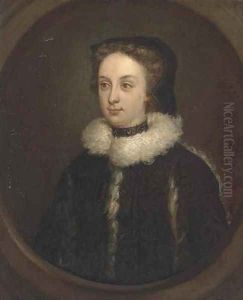George Jamiesone Paintings
George Jamesone, sometimes spelled Jamieson, was a Scottish portrait painter, often referred to as the 'Scottish Van Dyck.' Born in 1586 in Aberdeen, Scotland, Jamesone was the son of Andrew Jamesone, a master mason. He is considered one of Scotland's greatest portrait painters and was a contemporary of his Flemish counterpart, Anthony van Dyck, from whom he drew significant inspiration.
Jamesone likely began his artistic education under the guidance of local Aberdeen artists before traveling to Antwerp to further his training. It is believed that he studied under the portrait painter François Pourbus the Younger, though there is no surviving documentary evidence of his time in the Netherlands. After completing his training, Jamesone returned to Scotland around 1612 and established himself as a successful portrait painter among the Scottish nobility and gentry.
During his career, Jamesone painted numerous portraits that are characterized by their fine detail, rich colors, and the elegant portrayal of his subjects. Among his notable works are portraits of Mary Erskine, and the Marquis of Montrose. His work also includes the portrait of Sir Paul Menzies of Kinmundy, which is held in the collection of the Aberdeen Art Gallery.
His success led to a significant degree of wealth and social standing. In 1633, during Charles I's visit to Edinburgh, Jamesone was appointed as the king's painter in Scotland, a testament to his reputation at the time. His practice was not limited to individual portraits; he is also known for his allegorical and historical works, although fewer of these survive.
George Jamesone married Isobel Tosche in 1624, with whom he had at least eight children. His legacy continued through his family, as his daughter Mary Jamesone also became a painter, although little of her work survives. Jamesone's influence extended beyond his lifetime, with his work impacting the future of Scottish painting.
Jamesone died in Edinburgh in 1644, leaving behind a body of work that would secure his reputation as a pioneer of Scottish art. His portraits have provided an invaluable visual record of Scottish society during his lifetime. Despite the lack of comprehensive cataloging of his works, many of his paintings can be found in museums and private collections, where they continue to be appreciated for their craftsmanship and historical significance.
